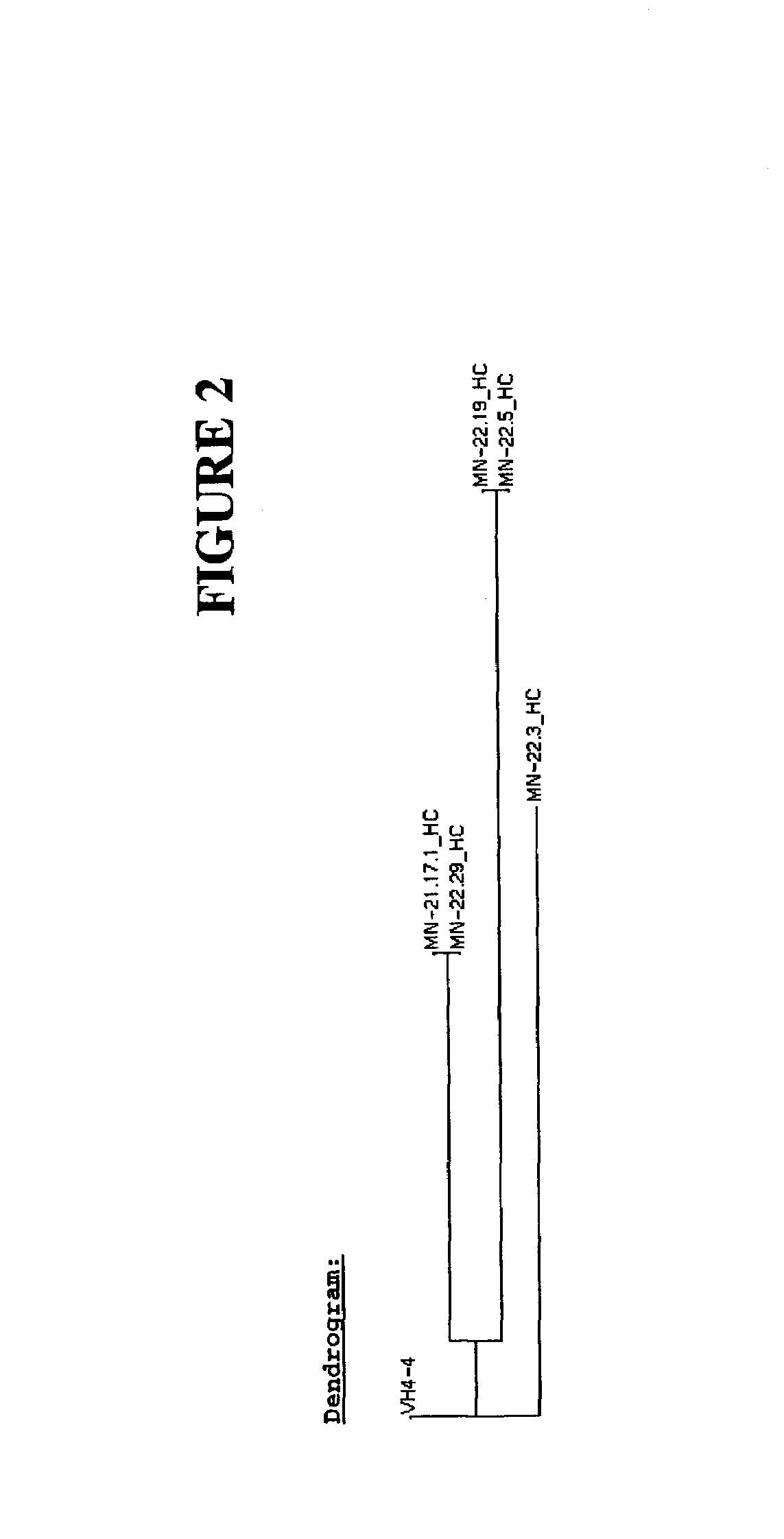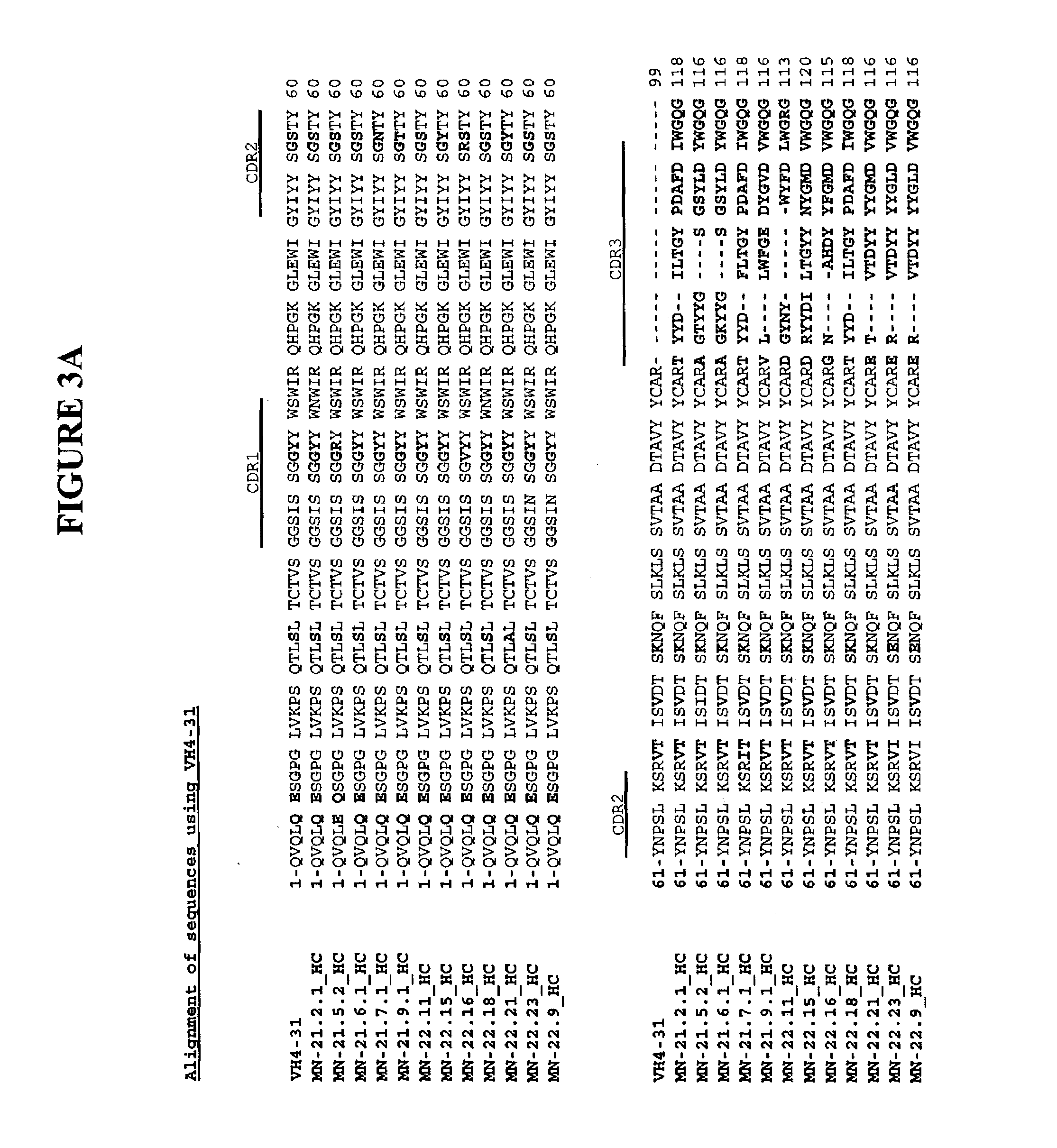Antibodies against carbonic anhydrase IX (CA IX) tumor antigen
a technology of carbonic anhydrase and tumor antigen, which is applied in the direction of antibody medical ingredients, peptide/protein ingredients, drug compositions, etc., can solve the problems of reducing the amount of dna that could be stably maintained, rendering the treatment of murine antibodies useless, and reducing the effect of biological activity
- Summary
- Abstract
- Description
- Claims
- Application Information
AI Technical Summary
Benefits of technology
Problems solved by technology
Method used
Image
Examples
example 1
Preparation of CA IX Tumor Antigens
[0148]In the present study, recombinant CA IX proteins were prepared. The full length CA IX cDNA was cloned by Reverse Transcriptase-PCR (RT-PCR) from human HT-29 cells (ATCC) with primers based on the sequence of Pastorek et al (Oncogene 9: 2877-2888 (1994)) NCBI Accession #X66839.
[0149]The primers used for the amplification of full length (FL) CA IX are as follows:
[0150]Forward primer: 5′-GTACACACCGTGTGCTGGGAC-3′ (SEQ ID NO: 120)
[0151]Reverse primer: 5′-CCTCAGATGCCTCTGGCTGG-3′ (SEQ ID NO: 121)
[0152]The ˜1.5 kb PCR product was cloned into pCR3.1 UNI (Invitrogen). Clone #15 was used as a template for PCR amplification of the extracellular domain (aa1-413 of CA IX with the following primers that incorporate a SalI site in the forward primer and a NheI site in the reverse primer):
[0153]Forward primer 5′-ATATTACGTCGACGTACACACCGTGTGCTGGAC-3′ (SEQ ID NO: 122)
[0154]Reverse primer 5′-CAGCTTAGAGCTAGCCCAGCAGCCAGGCAGGAATTCAGC-3′ (SEQ ID NO: 123)
[0155]The PCR...
example 2
Anti-CA IX Antibodies
[0156]A. Antibody Generation
[0157]1. Immunization and Selection of Animals for Harvesting by ELISA
[0158]Monoclonal antibodies against CA IX were developed by sequentially immunizing XM3B-3 and XMG2 mice with recombinant CA IX antigen. In particular, each mouse was immunized into its' hind footpad with CA IX recombinant antigen, generating a large number of candidate mAbs. These antibodies were then screened for binding and anti-CA IX activity. The mice were initially boosted, and again boosted 3-4 days later with HT-29 cells expressing CA IX at a concentration of 107 cells / mouse. Each mouse was further immunized into each hind footpad six additional times (at 3-4 day intervals) with soluble antigen, specifically 10 μg of CA-IX-IgG2-Fc. Four days after the final boost, sera from the immunized mice were tested by ELISA for titer against purified CA IX antigen bound to microtiter plates.
[0159]In some experiments determination of anti-CA IX titer was performed with ...
example 3
CA IX Expression
[0221]A. Expression of CA IX in Cancer Cells
[0222]To determine whether cancer cells express CA IX, 96 different cancer cells were incubated with anti-CA IX antibody and subsequently incubated with anti-human IgG-HRP in a cell based array (CBA).
[0223]The 96 different cancer cells were grown in respective medium, aliquoted into 96 well plates and incubated with 5 μg / ml of CA IX antibody, AB-MN-21.141 for 1 hour. The cells were washed 2 times and then incubated with the secondary antibody, goat anti-human IgG-HRP (Jackson Immunoresearch). After washing the secondary antibody, tetramethylbenzidine (TMB) substrate (Zymed) was added to each well. The OD was measured at 650 nm.
[0224]The graphs in FIGS. 24A and 24B represents the results of CA IX expression in a subset of the cancer cell lines tested in the CBA. Results showing expression levels of human CA IX in melanoma cell lines, SK-mel-5, Hs 936.T, LOX IMVI, M-14 SK-MEL-2, UACC-62 and UACC-257, cervical cancer cell line...
PUM
| Property | Measurement | Unit |
|---|---|---|
| Fraction | aaaaa | aaaaa |
| Fraction | aaaaa | aaaaa |
| Fraction | aaaaa | aaaaa |
Abstract
Description
Claims
Application Information
 Login to View More
Login to View More - R&D
- Intellectual Property
- Life Sciences
- Materials
- Tech Scout
- Unparalleled Data Quality
- Higher Quality Content
- 60% Fewer Hallucinations
Browse by: Latest US Patents, China's latest patents, Technical Efficacy Thesaurus, Application Domain, Technology Topic, Popular Technical Reports.
© 2025 PatSnap. All rights reserved.Legal|Privacy policy|Modern Slavery Act Transparency Statement|Sitemap|About US| Contact US: help@patsnap.com



